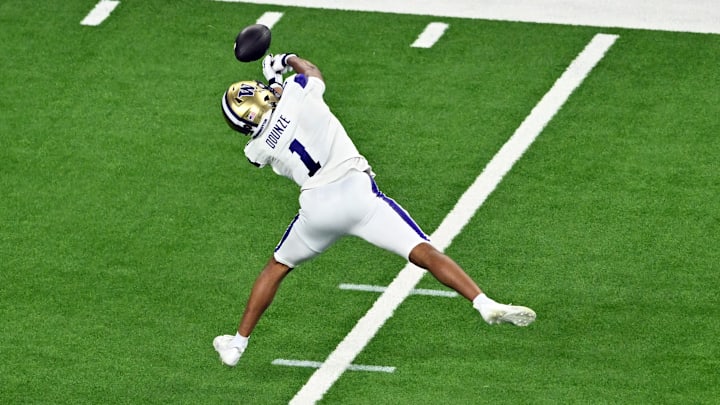In recent days, there's been a surge of speculation regarding the Kansas City Chiefs potentially trading up into the Top 15 or even Top 10 in this week's NFL draft. While many analysts anticipate this move to target a wide receiver like Rome Odunze or Malik Nabers, it's worth noting that bolstering the left tackle position remains a viable alternative.
While such a move would undoubtedly ignite excitement among Chiefs Kingdom, reminiscent of their bold move in 2017 when they leaped 17 slots to secure Patrick Mahomes, it might not necessarily align with the team's best interests in the long run.
While the potential of Rome Odunze, Malik Nabers, or even Brock Bowers to become franchise cornerstones for the next decade is enticing, the team's interests might be better served by either staying put or aiming for a more modest trade-up higher into the lows 20s rather than risking a move into the Top 10-15.
Despite the rumors, the Kansas City Chiefs shouldn't trade into the Top 10 of the 2024 NFL Draft.
If the Chiefs were to trade into the Top 10, let's use #9 with Chicago as an example. In addition to #32, they would likely need to surrender next year's first-round pick, along with either #64 or #95 this year, perhaps even adding another day 3 pick. That's three premium picks invested in a single player who's yet to prove himself in the NFL, and notably, isn't a quarterback.
Such trades are typically worth the risk when a team has the opportunity to secure a true franchise quarterback, akin to what the Chiefs achieved with Mahomes. However, acquiring surplus value becomes considerably more challenging when trading those significant assets for a position that isn't the most important in all of sports.
While acquiring superstars remains a priority for every team, individual non-quarterbacks often don't have as significant an impact as many fans or analysts perceive. For instance, according to Pro Football Focus ($), Chris Jones posted a WAR (Wins Above Replacement) of 0.7 in 2022, whereas Kirk Cousins boasted a WAR of 1.95 in 2023 (despite only playing in eight games). L'Jarius Sneed recorded a 0.64 WAR for his remarkable 2023 season. Is WAR a flawless statistic? Certainly not, but it illustrates that investing premium prices in non-quarterbacks isn't consistently prudent business.
If the Chiefs invest two first-round picks and another second-round pick in acquiring a wide receiver, they're essentially trading three selections for the price of one. Consequently, they'll have fewer picks available to address other crucial positions like left tackle and defensive tackle, both in 2024 and 2025. While they could potentially trade back to recover some assets, it's notably more challenging to fully restore the value lost when lacking a first-round pick next year and a second-round pick this year.
Conversely, non-quarterbacks such as Travis Kelce and Chris Jones have played pivotal roles in solidifying the Chiefs' dynasty. Thus, acquiring another franchise cornerstone could prove to be worth it, even if the true value doesn't align with the price paid. Additionally, draft picks are inherently risky. If, hypothetically, Rome Odunze or Malik Nabers develops into Top 3-5 wide receiver in Kansas City, while the players the Chiefs would have selected with the additional picks fail to deliver, it's challenging to argue that they made the wrong decision.
Trading a future first-round pick to move up for a non-quarterback is a bold move, albeit not without precedent. In 2011, the Falcons jumped from 27th to 6th to secure Julio Jones. Atlanta gave up picks No. 59 and 124 in the 2011 draft, along with their first and fourth-round selections in 2012, to Cleveland for the pick.
In 2014, the Bills orchestrated a move up from No. 9 to No. 4 (also with Cleveland), exchanging Buffalo's first and fourth-round picks in 2015. Their target: Sammy Watkins.
In 2018, aiming to fortify their defensive line for a potential Super Bowl run, the Saints traded up from No. 27 to No. 14 with the Packers. They relinquished pick No. 147 and a first-round pick in 2019 to land Marcus Davenport.
Among the three most notable trade-ups for non-quarterbacks, two didn't yield the desired results (Watkins and Davenport). While Julio Jones did develop into a first-ballot Hall of Famer, it's worth noting that he never secured a Super Bowl victory during his tenure with Atlanta, but he was close in 2016-17.
Moreover, trading up significantly might not be the wisest move given that this year's draft is widely regarded as boasting one of the deepest wide receiver and offensive tackle classes in recent memory. Considering the depth available, does it truly make sense to gamble the farm on a player at a position where the Chiefs could potentially land a standout talent at #32 or even with a modest trade-up into the 20s?
While Rome Odunze, Malik Nabers, and Brock Bowers are undoubtedly exceptional prospects, and I'd be thrilled to see any one of them as a Chief, they would undoubtedly be important pieces in the quest for a three-peat. However, the cost for Kansas City to secure them may outweigh their potential benefits. It would be wiser for the Chiefs to either maintain their current position or make a more modest move up within the 20s rather than undertaking a significant leap into the Top 10.
In my view, there's no NFL general manager better at his job than Brett Veach. If he and Andy Reid believe that the Chiefs should trade multiple premium picks for a wide receiver or offensive tackle, then who am I to doubt them? However, I personally have reservations about making such a move. Admittedly, many fans were upset when the team traded Tyreek Hill in March of 2022, yet Kansas City has won both Super Bowls since then. While I may not endorse the decision, I'll choose to trust the judgment of the team that has solidified itself as an NFL dynasty.
